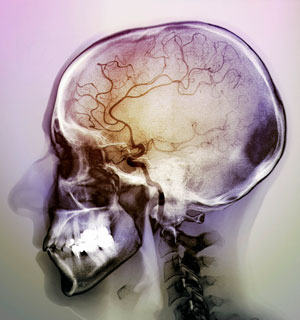May 18, 2018 Research Highlight Medicine / Disease
Meta-analysis of genome-wide association studies triples known genetic risk factors for stroke
An extensive genetic dragnet uncovers novel risk factors for stroke, offering both biological insights and potential disease-prediction tools
 Figure 1: Colored angiogram of the brain of a patient after a stroke. A huge international study has identified 32 genetic factors that increase the risk of stroke. © 2018 ZEPHYR/SCIENCE PHOTO LIBRARY
Figure 1: Colored angiogram of the brain of a patient after a stroke. A huge international study has identified 32 genetic factors that increase the risk of stroke. © 2018 ZEPHYR/SCIENCE PHOTO LIBRARY
A massive multinational effort, which included RIKEN researchers, has identified hereditary factors that increase the risk of stroke1. This will help clinicians better identify and treat high-risk patients.
Stroke is a major killer, being the second leading cause of death worldwide. While lifestyle factors such as smoking, insufficient exercise and excessive alcohol consumption considerably increase the risk of stroke, genetics also plays an important role—some people are more genetically predisposed to have a stroke than others.
But little is known about the genetic factors that increase the risk of stroke. “We know hundreds of DNA sequence features, or loci, associated with height and more than 100 for rheumatoid arthritis, but only about 10 robust loci for stroke,” comments Yoichiro Kamatani of the RIKEN Center for Integrative Medical Sciences.
For decades, geneticists have performed genome-wide association studies (GWAS) to identify loci associated with different traits and medical conditions within large populations.
A big challenge with GWAS is including enough subjects to detect relatively small but statistically meaningful signals. The international collaborative effort, in which Kamatani and other stroke geneticists around the world participated through the International Stroke Genetics Consortium, solved this problem by performing a broad meta-analysis of data gathered from 29 previously conducted GWAS, which encompassed genetic information from more than 67,000 stroke patients and over 450,000 control subjects.
Critically, these studies were performed in different communities around the world, allowing the researchers to home in on variants that might be associated with population-specific risk.
“This is important because the epidemiology of stroke differs between countries,” says Kamatani. He notes that such a ‘trans-ethnic meta-analysis’ required some formidable statistical crunching, as the broader spectrum of genetic differences between ethnic groups can make it hard to decipher the signal from the noise.
But the effort paid off. “We found 32 loci,” says Kamatani, “essentially tripling the number of stroke-associated loci.”
Many of these loci make sense from a biological perspective—for example, genetic markers linked to high blood pressure or setting the heart rate. But others were unexpected risk factors that invite further investigation. The researchers also found that the genes at these loci were associated with multiple drug targets for antithrombotic therapy, a standard treatment for acute stroke. This warrants looking for new drugs based on the genetic findings.
Collectively, these data offer a valuable starting point for understanding the pathology of different stroke subtypes, particularly those that are more prevalent in understudied, non-European populations.
Kamatani envisions that the data could be used to develop a powerful prognostic tool. “This will contribute to the construction of a genetic score for predicting the risk of stroke,” he says.
Related contents
References
- 1. Malik, R., Chauhan, G., Traylor, M., Sargurupremraj, M., Okada, Y., Mishra, A., Rutten-Jacobs, L., Giese, A. K., van der Laan, S. W., Gretarsdottir, S. et al. Multiancestry genome-wide association study of 520,000 subjects identifies 32 loci associated with stroke and stroke subtypes. Nature Genetics 50, 524–537 (2018). doi: 10.1038/s41588-018-0058-3
